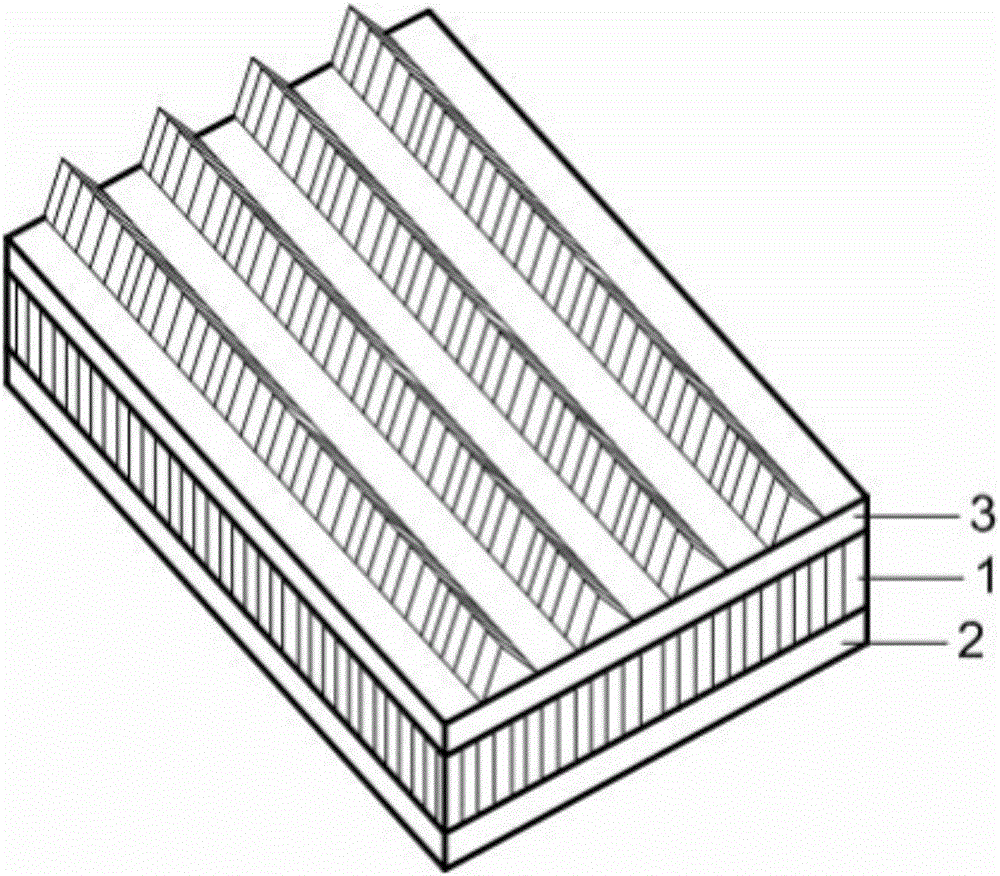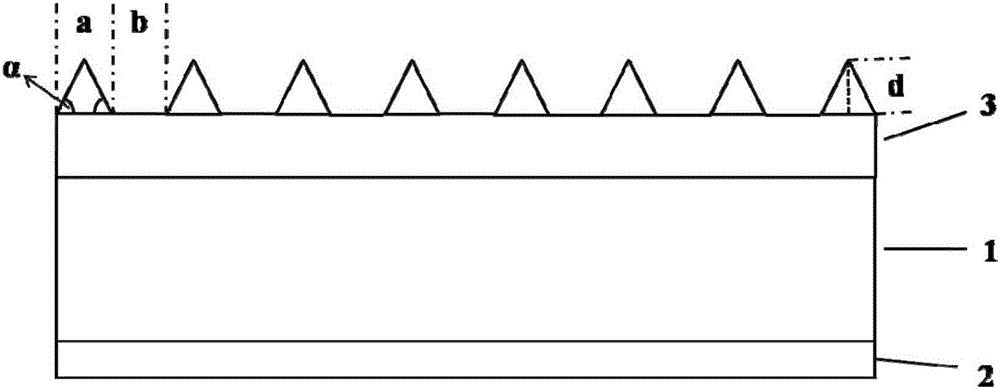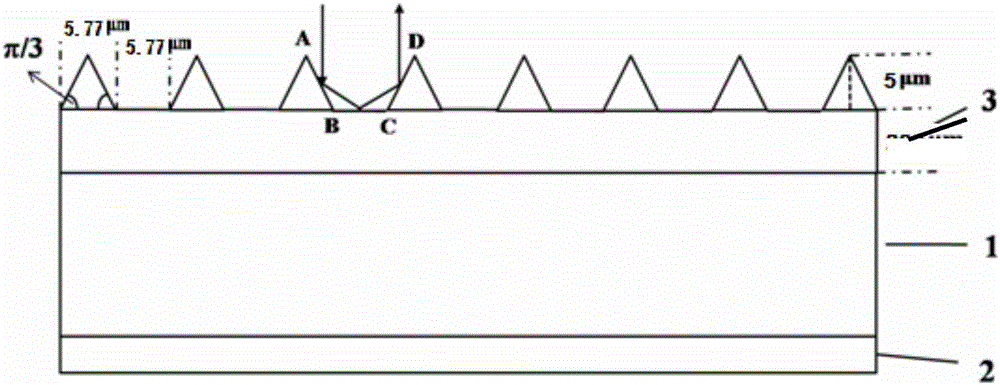Patterned power-gain type solar back plate material
A solar backplane and power gain technology, applied in photovoltaic power generation, electrical components, circuits, etc., can solve problems such as difficult to achieve composition systems, achieve good controllability and long-term reliability, stable production process, and high reflectivity Effect
- Summary
- Abstract
- Description
- Claims
- Application Information
AI Technical Summary
Problems solved by technology
Method used
Image
Examples
Embodiment 1
[0054] The backplane manufacturing process is as follows:
[0055] First, the intermediate layer ingredients are polyethylene terephthalate (U.S. DuPont) 60wt%, titanium dioxide R902 (U.S. DuPont) 35wt%, hydrolysis stabilizer phenyl glycidyl ether (Hongyu Chemical Co., Ltd.) 4wt %, anti-thermal oxygen aging agent 2'-methylene bis-(4-methyl-6-tert-butylphenol) (Germany BASF) 1wt%. After mixing evenly, melt processing at 250-300°C.
[0056] The batching of pattern layer is ethylene-propylene copolymer (U.S. Dow Chemical Company) 50wt%, 3-(methacryloyl chloride) propyltrimethoxysilane (Sartomer Company) 4.9wt% and methacrylic acid hydroxyl Ethyl ester (Sartomer Company) 4wt%, flaky wet-process mica powder (Fengshuo Chemical Co., Ltd.) 5wt%, ceramic microspheres (King Kong New Materials Co., Ltd.) 10wt%, titanium dioxide R706 (U.S. DuPont) 25wt%, UV Absorber 2-[4-[2-Hydroxy-3-dodecyloxypropyl]oxy]-2-hydroxyphenyl]-4,6-bis(2,4-dimethylphenyl) -1,3,5-triazine (Germany BASF) 0.05w...
Embodiment 2
[0063] The backplane manufacturing process is as follows:
[0064] First, the intermediate layer ingredients are polybutylene terephthalate (U.S. DuPont Company) 95wt%, UV absorber 2-(4,6-bis(2,4-dimethylphenyl)-1,3, 5-triazin-2-yl)-5-octyloxyphenol (BASF, Germany) 1wt%, light stabilizer 2,2,6,6-tetramethyl-4-piperidine stearate (Taiwan bis Bond Chemical Company) 1wt%, hydrolysis stabilizer P400 (Germany Rheinland Chemical Company) 2.5wt%, anti-thermal oxygen aging agent triethylene glycol ether-two (3-tert-butyl-4-hydroxyl-5-methylphenyl ) Propionate (Taiwan Yongguang Chemical Company) 0.5wt%. After mixing evenly, melt processing at 250-300°C.
[0065] The batching of pattern layer is ethylene-propylene copolymer (Netherlands Lian DeBasell company) 85wt%, glycidyl methacrylate grafted polyethylene (Sartomer company) 5wt% and polyethylene glycol monomethacrylate (Manor Chemical Co., Ltd.) 5wt%, flaky talcum powder (Chuangyu Chemical Co., Ltd.) 1wt%, glass microspheres (3M C...
Embodiment 3
[0071] The backplane manufacturing process is as follows:
[0072] First, the intermediate layer ingredients are polyethylene naphthalate (Changchun, Taiwan) 70wt%, glass fiber powder (Xiangu Technology Co., Ltd.) 21wt%, ultraviolet absorber 2-[4-[2-hydroxyl-3- Dodecyloxypropyl]oxyl]-2-hydroxyphenyl]-4,6-bis(2,4-dimethylphenyl)-1,3,5-triazine (Taiwan Double Bond Chemical Co. ) 0.54wt%, light stabilizer 2,2,6,6-tetramethyl-4-piperidine stearate (Taiwan Double Bond Chemical Company) 0.459wt%, hydrolysis stabilizer type I (Rheinland Chemical) 8wt %, anti-thermal oxygen aging agent 3,9-dioctadecyloxy-2,4,8,10-tetraoxo-3,9-diphosphospiro[5.5]undecane (Nanjing Hengqiao Chemical Company) 0.001 wt%. After mixing evenly, melt processing at 250-300°C.
[0073] The batching of pattern layer is ethylene-octene copolymer (Taiwan Fu poly chemical company) 89wt%, maleic anhydride grafted polyethylene (Sartomer company) 3wt% and triallyl isocyanurate (Chuangzhuang Chemical Co., Ltd. Compa...
PUM
| Property | Measurement | Unit |
|---|---|---|
| Thickness | aaaaa | aaaaa |
| Particle size | aaaaa | aaaaa |
| Particle size | aaaaa | aaaaa |
Abstract
Description
Claims
Application Information
 Login to View More
Login to View More - R&D
- Intellectual Property
- Life Sciences
- Materials
- Tech Scout
- Unparalleled Data Quality
- Higher Quality Content
- 60% Fewer Hallucinations
Browse by: Latest US Patents, China's latest patents, Technical Efficacy Thesaurus, Application Domain, Technology Topic, Popular Technical Reports.
© 2025 PatSnap. All rights reserved.Legal|Privacy policy|Modern Slavery Act Transparency Statement|Sitemap|About US| Contact US: help@patsnap.com



